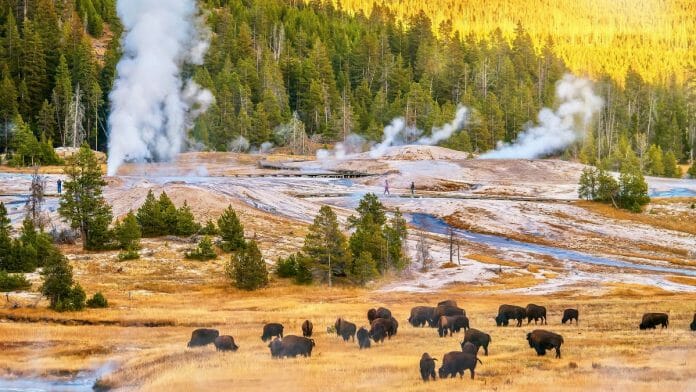[ad_1]
While all the crowds gather to watch Old Faithful erupt, follow a series of boardwalks and paved and dirt trails through Yellowstone’s Upper Geyser Basin to see more incredible geysers and hot pools and find a sense of solitude. At Upper Geyser Basin, you can walk up to 6 miles to experience the highest concentration of geysers in the world.
Along the way you’ll pass stunning blue, orange and yellow hot pools, have to duck from the mist of erupting geysers, watch the Firehole River steam and hopefully catch a glimpse of the park’s abundant wildlife from grazing bison to herds of elk.
Where Is the Upper Geyser Basin?
Upper Geyser Basin is located in the heart of Yellowstone and encompasses the Old Faithful complex including hotels, restaurants and a visitor center. You can access Upper Geyser Basin from either the north or the south end of the basin. Most people access it from the south and park at the Old Faithful complex. Head to Old Faithful itself, which is located just behind Old Faithful Inn and the Old Faithful Visitor Education Center. From there, you can follow the paved bike path on the left, or head out on the boardwalks to the right. If you don’t want to miss any features, make sure you take one option on the way in and the other on the way out.
If you want to avoid the crowded Old Faithful area, you can also park at the Biscuit Basin lot. From here you can explore the geysers, springs and pools on this basin’s boardwalks before crossing the road and following the trail directly across from the lot. You’ll know you’re on the right track when you quickly encounter Mirror Pool on your right. This part of the basin is not wheelchair accessible.
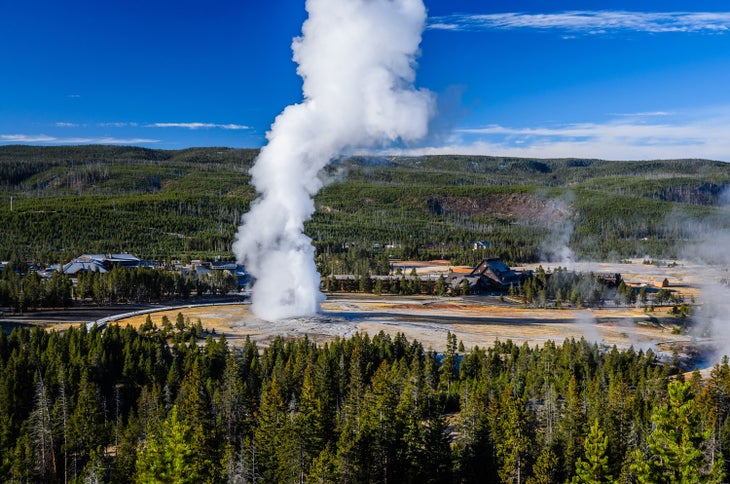
How Long Does It Take to Walk the Upper Geyser Basin?
The best part about the Upper Geyser Basin is that you can walk as far or as short as you like and experience a huge array of amazing thermal features. If you walk all the way to Biscuit Basin from Old Faithful and make a loop on the way back so you don’t miss any features, the entire trip will be just over 6 miles with less than 400 feet of elevation gain.
If you want to escape the crowds, plan on heading at least a mile out into the basin to start to find some solitude. For a fun, shorter loop follow the boardwalks on the east side of the basin until you meet up with the paved bike path. Then, head back to Old Faithful on the paved path with a detour around the Daisy Geyser loop. This route is just over 3 miles.
Plan for half a day or more to explore the entire loop. You’ll want to give yourself plenty of time to stop and admire any active geysers, watch wildlife you might encounter and take lots of photos. Pack a picnic lunch to eat along the way at one of the picnic tables scattered throughout the area. Some geysers in this basin are very predictable. The park usually has predictions on when the next eruption will occur posted in the Visitor Center and online (www.nps.gov/yell/learn/nature/hydrothermal-features.htm) for Old Faithful, Castle, Grand, Daisy and Riverside. It’s worth timing your walk to coincide with at least one of these impressive eruptions but chances are if you spend several hours out in the basin, you’ll see at least one eruption or two.
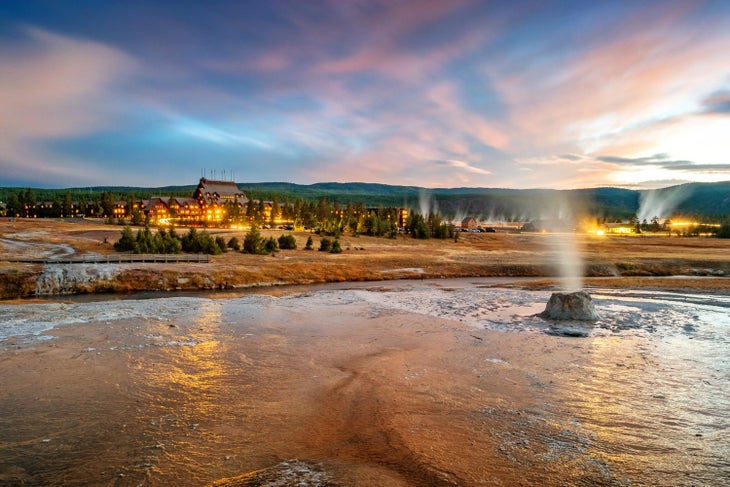
How Many Geysers Are in the Upper Geyser Basin?
There are more than 150 thermal features in Upper Geyser Basin, stretching approximately three miles from Old Faithful to Biscuit Basin. To see them all, set aside a half day or more to walk the full loop that clocks in at just over 6 miles.
Start just behind the Old Faithful Visitor Center and follow the path around the famous geyser.

Old Faithful
Old Faithful is one of the most famous geysers in the world. The first white settlers to discover the geyser were the Washburn Expedition in 1870, who stumbled upon the geyser during eruption. Due to the geyser’s frequent eruptions, Washburn Expedition members named it “Old Faithful.” A good name, since Old Faithful geyser has erupted more than a million times since Yellowstone became the world’s first national park in 1872.
On average, Old Faithful erupts every 65-95 minutes. Old Faithful shoots a column of water 100-130 feet into the air and the length of the geyser’s eruption determines how long it will be before the next eruption occurs. Longer geyser eruptions mean waiting longer to see the next eruption.

Old Faithful, like most of the park’s geysers, gets its water from the depths of the Earth. Snow and rainwater reach depths of about 10,000 feet below the Earth, at which point it’s heated by the magma body, which forces it up through the surface.
From behind Old Faithful, a set of boardwalks heads right, crossing the Firehole River. You can either head right again, following signs for Observation Point where you’ll get an elevated view of the basin after a steep climb, or you can stay left at the fork to circle Geyser Hill. Don’t miss Beehive Geyser and Heart Spring, a gorgeous turquoise pool shaped like a heart.
Beehive Geyser
Beehive is a classic cone geyser. Its vent is narrow – just eight inches in diameter – and acts like a nozzle so that a slender column of water is shot under great pressure. Average eruptions are around 150 feet high, but the geyser has been known to shoot water as high as 200 feet.
Beehive is one of the more forceful, powerful geysers in the basin. Water shoots through an eight-inch opening, and as a result, eruptions are very loud. It’s a spectacular show when it erupts.
After you loop Geyser Hill, continue north along the boardwalk. After passing a few more pools and geysers, you’ll reach Grand Geyser. This is the tallest predictable geyser in the world, erupting with a 150-200-foot spray every four to eight hours.
Continue north, passing Sawmill Geyser.
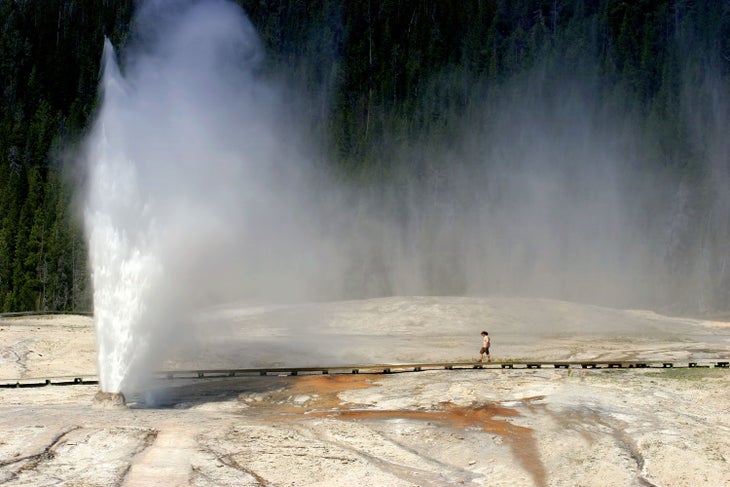
Sawmill Geyser
Sawmill Geyser is situated and connected to approximately 10 other geothermal features that all compete for energy and water. Each geothermal feature pulls and draws energy and water from one another.
One geyser starts pulling water, so the others in the group have to wait until that particular active geyser is done and has a chance to fill up again. Eventually, the whole system fills as one.
Sawmill is a fountain geyser and erupts in bursts and surges. It erupts frequently. In fact, it’s more common to see it in eruption than not in eruption.
Notice how the different pools have different colors of water, or multi-colored rings in one pool. This is because these hot springs are full of microbes that thrive in the scalding hot pools. Different bacteria are responsible for the different colors and thrive in different pools or different parts of the same pool based on the temperature and pH of the environment.
The boardwalks will cross the Firehole River again and join up with the paved bike path. Unless Daisy Geyser is actively going off, keep heading north and save that detour for your return trip. From the bike path, you’ll spy Riverside Geyser across the steaming waters of the Firehole River.

Riverside Geyser
Riverside shoots water at a 60-degree angle across the Firehole River every six hours or so. The water shoots about 80 feet across the river’s surface. Check this geyser out in the afternoon and you may even see a rainbow amidst the eruption. This geyser erupts for about 20 minutes at a time.
The bike path crosses the river again before the pavement ends at the trail’s only restroom and Morning Glory Pool.

Morning Glory Pool
Morning Glory has a delicate, scalloped border and the center is a beautiful baby blue color. However, it’s been severely impacted by human behavior across history. People have thrown all sorts of objects into the pool which have blocked its heat vents and changed the temperature of the water, causing other microorganisms to move in and turn the border of the pool orange and yellow.
From the end of the pavement, continue on the dirt trail which follows the Firehole River. The thermal features are farther apart in this part of the basin, so keep your eyes peeled for wildlife like bison and elk.
Just after Mirror Pool, carefully cross the road and continue on to the boardwalk through Biscuit Basin. Follow the boardwalk loop clockwise, admiring the deep blue Sapphire Pool and Jewel Geyser if its erupting. Retrace your steps past Jewel, Shell and Avoca geysers to meet up with the dirt trail that heads south.
Follow the path across the creek and then carefully cross the road again. This path runs along the Firehole River’s west side and doesn’t have any thermal features until you reach the Daisy Geyser loop.
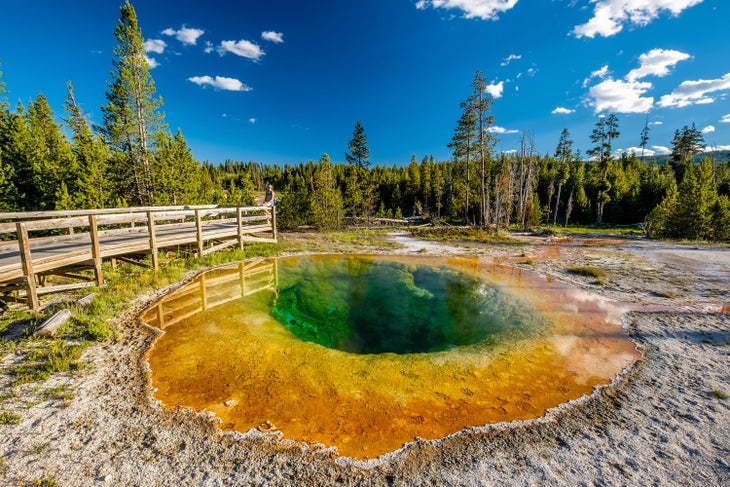
Daisy Geyser
Daisy Geyser erupts at an angle and will shoot water 75 feet high. Daisy is one of the park’s most predictable and frequent eruptions. Most days, there will be an eruption every 120-210 minutes unless the nearby Splendid Geyser erupts and changes Daisy’s pattern.
Either follow the boardwalk around the loop back to the bike path or if you have extra energy follow the trail past Punch Bowl Spring to Black Sand Basin, another area with half a dozen or so thermal features. After coming back out onto the paved bike path from the Daisy loop, continue south. Just before you reach the Old Faithful complex where you first started, you’ll pass Castle Geyser.

Castle Geyser
Castle has an intense eruption that lasts 20 minutes or so before the water has been eliminated and it begins to roar like a steam train for 30-40 minutes.
Castle erupts from one of the largest cones in the Upper Geyser Basin. Its cone is 30 feet tall. Castle erupts about approximately every 14 hours.
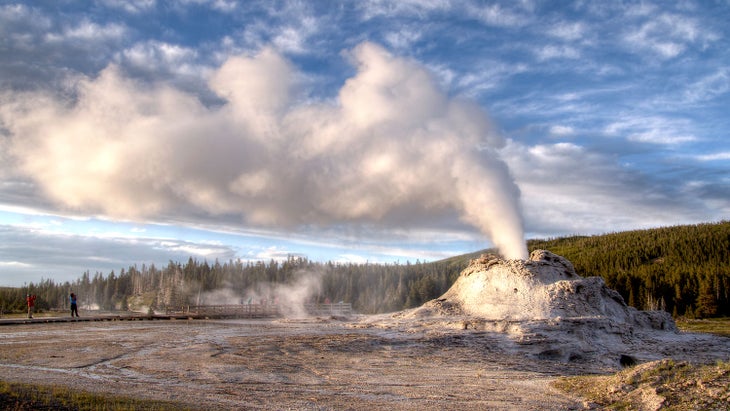
Why Is the Upper Geyser Basin Important?
While Yellowstone as a whole is home to the majority of the world’s geysers at 60%, Upper Geyser Basin holds the highest concentration on the planet. This designation alone makes it a spectacular natural wonder, but it has also played a huge role in scientific advancement.
Yellowstone’s many thermal features have allowed scientists the opportunity to discover incredible microbes that live in the hot pools. Some actually feed on CO2 and could help us combat climate change, some could help develop more heat-resistant crops and perhaps the most famous, an enzyme that led to the development of the Polymerase Chain Reaction (PCR) which was instrumental in developing tests to detect COVID-19 in 2020.
Are Geysers Dangerous?
Multiple people have died in Yellowstone’s geothermal features and more have been severely injured. Geysers, hot springs and pools and mud pots are no joke. Their temperatures can be extreme and though the ground around them may look solid, it’s often a thin crust that would collapse if stepped on.
Always stay on the boardwalks or marked trails in geyser basins. There aren’t usually guard rails keeping you from falling into thermal features, so stick to the middle of the boardwalks. Be mindful when taking photos not to get so carried away you put yourself in a dangerous situation. The best idea is to only move your feet when the camera viewfinder is away from your face. Be mindful passing others on the boardwalks and watch for slippery sections after a geyser’s spray soaks the boards.
Keep an eye on small children and elderly members of your group as a stumble could easily be fatal. Pets are not allowed on the boardwalks or trails in Upper Geyser Basin.
While Upper Geyser Basin is a developed and well-used part of the park, its always a good idea to carry bear spray when hiking in Yellowstone and to know how to use it.
The post Lose the Crowds in Yellowstone’s Upper Geyser Basin appeared first on Yellowstone National Park.
[ad_2]
This article was originally published on https://www.yellowstonepark.com/ on 2022-05-26 12:35:32


